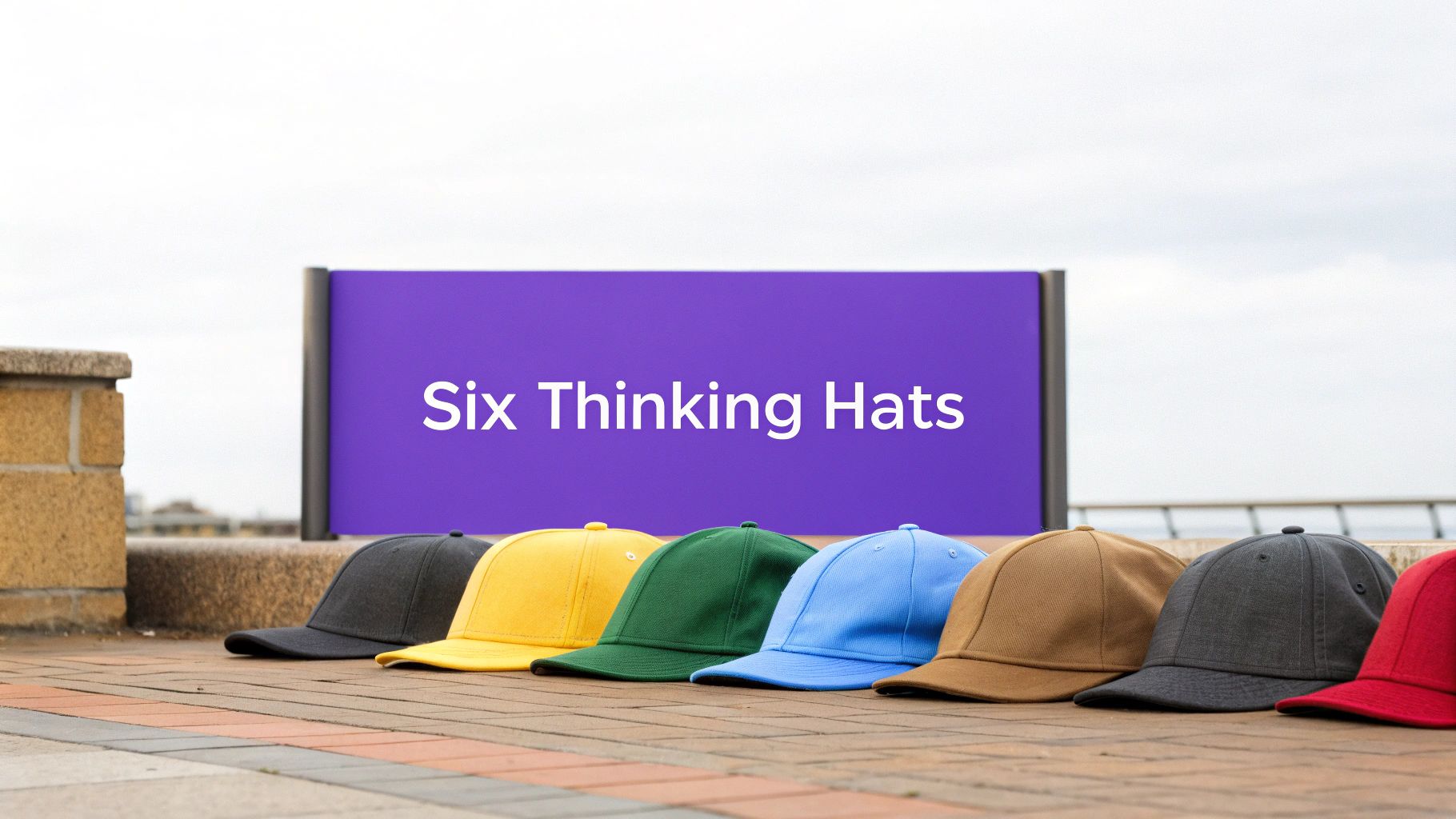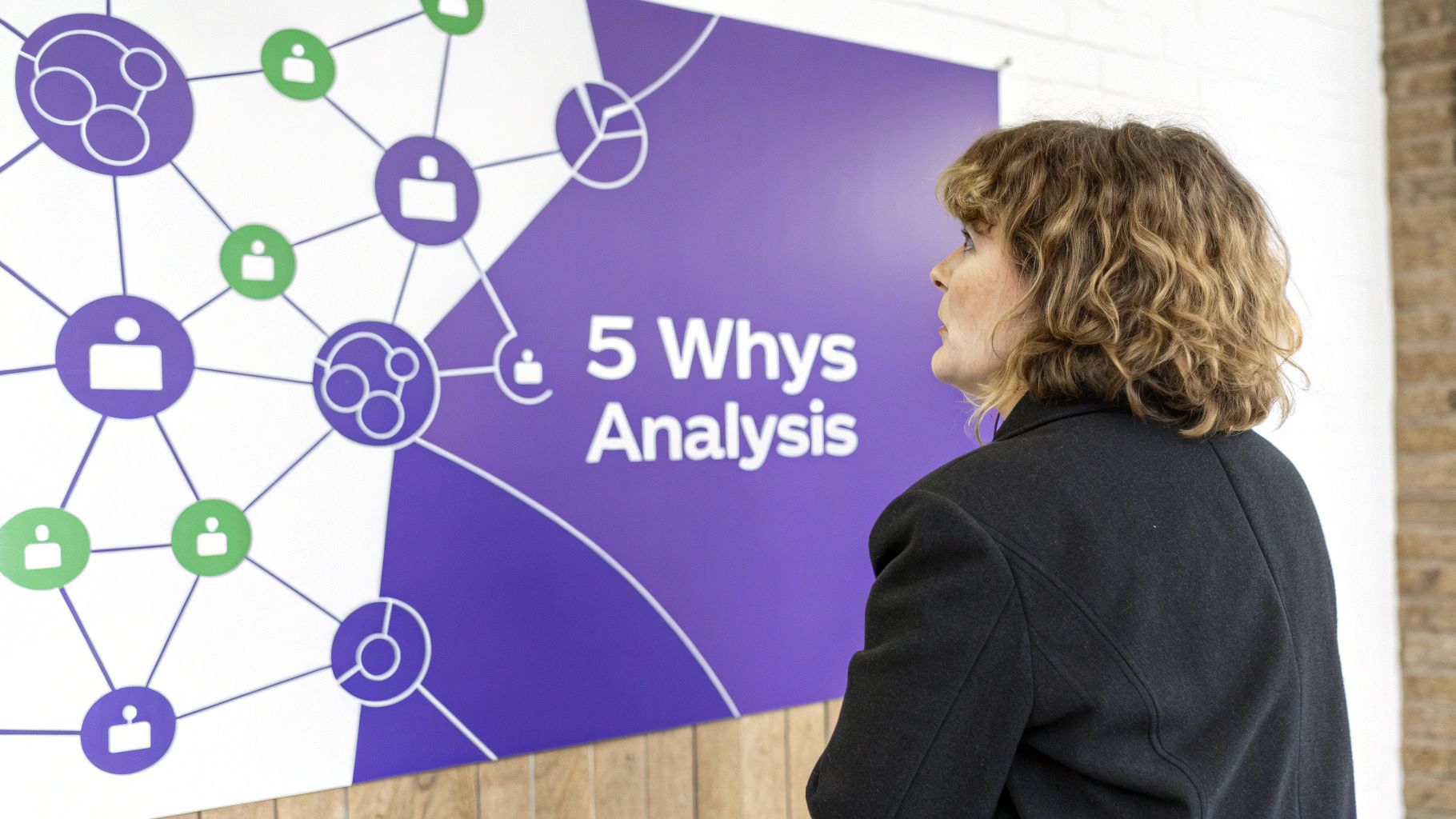Stuck in a Rut? Transform Your Problem-Solving Skills
For remote teams and startups, strong problem-solving abilities make the difference between success and stagnation. When deadlines are tight, bugs appear unexpectedly, and market conditions shift rapidly, standard approaches often fall short. That's why mastering creative problem-solving methods is essential in our complex work environments. These strategies give teams real tools to tackle challenges head-on.
The field of problem-solving has come a long way since the early days of structured brainstorming in the 1950s. Modern approaches like design thinking have proven their worth across industries – from product development to team communication. The most effective methods share key traits: they push teams to look beyond obvious solutions, question core assumptions, and actively incorporate diverse viewpoints. This is especially valuable for remote teams spread across different locations and time zones.
This article explores 10 practical problem-solving techniques that can help your remote team break through mental blocks and uncover innovative solutions. We'll show you how to build a culture of creative thinking and give your team the frameworks they need to tackle any challenge. Let's dive in and discover how to solve problems more effectively together.
1. Design Thinking

Design Thinking focuses on solving complex problems by putting people first. At its core, this method helps teams deeply understand user needs through empathy, idea generation, and quick testing of solutions.
Understanding Design Thinking
The Design Thinking process follows five key steps:
- Empathize: Connect with users to understand their real needs and challenges
- Define: Set clear problem statements to guide solution development
- Ideate: Create many potential solutions without judgment
- Prototype: Build simple test versions to explore ideas quickly
- Test: Get feedback from real users to improve solutions
Real-World Examples
Here's how leading companies have used Design Thinking successfully:
- IDEO created a better shopping cart by focusing on what shoppers actually needed
- IBM improved its products by making them more user-friendly
- Airbnb grew by fixing customer pain points in their booking experience
Background and Growth
IDEO and the Stanford d.school helped popularize Design Thinking, along with thought leaders like Tim Brown. Their work showed how focusing on user needs leads to better solutions.
Practical Tips
For teams working remotely, especially in tech startups, here's how to make Design Thinking work:
- Do thorough user research: Learn exactly what your users need
- Mix up your team: Include people with different skills and backgrounds
- Learn from mistakes: See failures as learning opportunities
- Keep good records: Write down insights and reasons for decisions
Why It Works
Design Thinking stands out because it helps create solutions that users actually want and need. Its focus on testing and improving makes it work well across many different fields.
Key Features
- User Focus: Everything starts with understanding user needs
- Testing and Improving: Solutions get better through repeated testing
- Team Cooperation: Different viewpoints lead to better answers
Benefits and Challenges
Benefits:
- Puts users first
- Supports testing new ideas
- Reduces risks
- Works in many industries
Challenges:
- Takes time
- Needs good team support
- Not right for every problem
Design Thinking helps remote teams work better together and adapt to change. To learn more about implementing this approach, visit IDEO's website.
Teams that use Design Thinking can better solve problems and create solutions their users truly value.
2. Six Thinking Hats

Edward de Bono's "Six Thinking Hats" method helps teams solve problems by looking at them from different angles. Teams put on different colored "thinking hats" to examine issues thoroughly and get input from every perspective. This approach works especially well for complex problems that need careful consideration.
How the Six Hats Work
Each hat represents a specific way of thinking:
- White Hat – Facts and data: What information do we have? What are the facts?
- Red Hat – Feelings and intuition: What's your gut reaction? How do people feel?
- Black Hat – Risks and challenges: What could go wrong? What are the drawbacks?
- Yellow Hat – Benefits and opportunities: What are the advantages? What could work well?
- Green Hat – New ideas and creativity: What fresh approaches could we try?
- Blue Hat – Process management: How should we proceed? What's our next step?
Using these different perspectives helps teams look at problems from all sides and make better decisions.
Key Benefits
- Clear Structure: Follows a set pattern so nothing gets missed
- Easy to Remember: Colors help people recall each thinking style
- Flexible Use: Works for both individual thinking and group discussions
- Less Personal: Keeps debates focused on ideas rather than personalities
- Better Choices: Leads to decisions based on complete analysis
- Full Picture: Makes sure every angle gets considered
Strengths and Limitations
Strengths:
- Reduces arguments and personal bias
- Improves decision quality
- Ensures thorough analysis
- Easy to learn and use
Limitations:
- Can feel unnatural at first
- Takes time to master
- May slow down quick decisions
Real Examples
Major organizations have used Six Thinking Hats successfully:
- Boeing: Uses it to consider all angles when making engineering choices
- Siemens: Includes it in leadership programs to build problem-solving skills
- NASA: Applies it in meetings to catch possible risks and encourage new ideas
Making It Work
Here's how to use Six Thinking Hats effectively:
- Start with a Guide: Have someone lead the process until the team gets comfortable
- Keep to Order: Move through the hats in a planned sequence
- Watch the Clock: Set time limits for each thinking style
- Include Everyone: Get input from all participants on each perspective
Six Thinking Hats stands out as a practical tool for remote teams, especially in tech companies and startups. It gives groups a clear way to tackle tough problems together and reach smart decisions that everyone supports.
3. SCAMPER Technique
The SCAMPER Technique helps teams develop creative solutions by making specific changes to existing products or services. Created by Bob Eberle and Alex Osborn, this method provides a clear framework for quickly generating ideas. It's especially helpful for remote teams, tech companies, and startups looking for practical ways to improve their offerings.
Understanding the SCAMPER Technique
The technique uses seven questions built around its acronym:
- Substitute: What parts could be replaced to make improvements?
- Combine: Which elements could work better together?
- Adapt: How can we adjust things to work in new situations?
- Modify: What changes to form, shape, or features would help?
- Put to Another Use: What new ways could we use this?
- Eliminate: Which parts aren't needed?
- Reverse: How could we rearrange or flip things around?
Real-World Examples and Case Studies
Many successful products came from SCAMPER thinking. The Sony Walkman shows "Substitute" by making music portable instead of stationary. Post-it Notes demonstrate "Put to Another Use" – they started as a failed strong adhesive that found a better purpose. McDonald's drive-through shows "Combine" by mixing fast food with car service.
Evolution and Popularity
SCAMPER took shape in the mid-1900s. Bob Eberle created the acronym to make brainstorming simpler, while Alex Osborn helped spread its use across different industries.
Tips for Effective Implementation
Get the most from SCAMPER with these tips:
- Work through each prompt: Give every letter in SCAMPER proper attention
- Mix with other methods: Pair it with mind mapping or design thinking
- Keep good records: Write down all ideas for later review
- Build together: Help teammates develop their ideas further
Why SCAMPER Deserves Its Place
SCAMPER stands out because it's easy to learn and fits many situations. Remote teams and startups find it helpful for quick problem-solving. While it may not always lead to breakthrough ideas, it helps teams steadily improve existing solutions.
Pros and Cons
Pros:
- Clear structure for creativity
- Works in many situations
- Easy to remember
- Quick results
Cons:
- May not create revolutionary ideas
- Starts with existing solutions
- Needs something to modify
The SCAMPER technique helps teams think creatively and solve problems better. For more details and examples, check out Mind Tools' SCAMPER guide.
Teams can use SCAMPER to keep improving their work and find new solutions that match what customers want.
4. Mind Mapping
Mind mapping is an effective way to organize thoughts and solve problems visually. This method creates a visual diagram of ideas radiating from a central theme, helping teams spark new solutions. Tony Buzan helped popularize mind mapping and develop its key principles.
Understanding and Application
A mind map starts with the main concept in the center, with related ideas branching outward. This structure lets thoughts flow naturally and shows how different concepts connect. Using colors and images makes complex information easier to grasp. For remote teams working on technical projects, mind mapping can transform brainstorming sessions into focused collaboration.
Real-World Examples and Case Studies
Many leading companies use mind mapping successfully. Disney incorporates it when developing animated features to connect story elements. Amazon uses mind maps during product development to unite different teams and generate new tech ideas. TED speakers often create mind maps to structure their talks and craft compelling narratives.
Evolution and Practical Use
Tony Buzan took mind mapping beyond basic note-taking by emphasizing visual creativity. The technique's ability to boost memory and understanding has made it popular in both creative and business settings. Remote teams find it especially useful since it adapts well to different project sizes and types.
Practical Tips for Implementation
- Start Simple: Put your main topic in the center to maintain focus
- Use Color With Purpose: Different colors for branches help with visual organization
- Keep It Clean: Make branches distinct and use short, clear descriptions
- Update Regularly: Review and adjust your mind map as the project evolves
Why Mind Mapping Works
Mind mapping stands out because it lets teams think freely and find unexpected solutions. Remote teams can use it to work together more effectively on complex problems. However, some people who prefer linear thinking may find it challenging, and complex topics can become messy.
Pros and Cons
Pros:
- Better memory retention
- Clear relationship mapping
- Sparks new connections
- Works for many situations
Cons:
- Can get disorganized with complex topics
- Not ideal for linear thinkers
- Takes practice to use well
Mind mapping gives remote teams a powerful tool for creative problem-solving and better teamwork.
Learn more about Tony Buzan and mind mapping at Tony Buzan's Official Website.
5. 5 Whys Analysis
Understanding the root cause of problems is essential for any team. The 5 Whys Analysis helps teams dig deeper by repeatedly asking "why" to uncover what's really causing an issue. This simple but effective method works well for remote tech teams, startups, and any group looking to improve their problem-solving.

How It Works
The method involves asking "why" five times to get to the core of a problem. Rather than just looking at surface-level symptoms, teams explore the connections between causes and effects. Remote tech teams find this especially helpful when troubleshooting complex software issues since it provides a clear, systematic approach.
Real Examples
Toyota made this method famous by using it to improve their manufacturing quality. NASA also uses the 5 Whys to investigate technical problems with spacecraft. Hospitals apply it to prevent medical errors and improve patient care.
History
Sakichi Toyoda created this technique at Toyota Motor Corporation, where it became central to their engineering approach. Its success there led other industries to adopt it as a way to find and fix root causes.
Tips for Success
- Focus on one path: Pick a single problem thread and follow it through to avoid confusion
- Use real data: Base your analysis on facts rather than guesses
- Include experts: Have team members who understand the problem participate
- Keep records: Write down all answers for future reference
Key Benefits
- Easy questioning process: Teams can uncover deeper issues by simply asking "why"
- Gets to root causes: Helps address the true source of problems
- Step-by-step approach: Breaks down complex issues into manageable pieces
- Clear process: Provides a straightforward path to understanding problems
Strengths and Limitations
Strengths
- Quick to learn: Teams can start using it right away
- Finds core issues: Helps prevent problems from coming back
- Cost-effective: Needs minimal resources
- Fast results: Produces useful insights quickly
Limitations
- Can be too simple: Some problems need more complex analysis
- Depends on perspective: Different people may identify different causes
- Needs accurate input: Results only as good as the information provided
The 5 Whys Analysis remains a practical tool for remote teams because it encourages working together to solve problems through careful questioning and analysis.
6. Lateral Thinking
Lateral thinking is a creative approach to problem-solving developed by Edward de Bono that encourages exploring solutions through non-traditional and imaginative reasoning. Rather than following a standard linear path, it pushes teams to seek inventive solutions by looking at problems from entirely new angles.
Breaking Away from Linear Thinking:
Traditional problem-solving tends to follow a step-by-step process. Lateral thinking takes a different route – it emphasizes non-linear thinking, breaking established patterns, and examining multiple viewpoints. For remote teams spread across different locations, this approach opens up new possibilities for tackling collaboration and communication challenges.
Real-World Success Stories:
Consider WD-40's origin story: What started as a rust-prevention formula for aerospace became a widely-used multi-purpose solution through accidental discovery. Uber changed transportation by directly connecting drivers and riders. Dyson reimagined vacuum cleaners by questioning the need for bags, leading to their breakthrough cyclone technology.
Development Over Time:
Edward de Bono's work in the 1960s gave structure to lateral thinking concepts. He noticed that our minds naturally default to logical, sequential thinking (vertical thinking) and showed how practicing lateral thinking helps spark creativity and fresh ideas. This skill proves especially valuable for remote teams facing unique challenges.
Key Ways to Apply Lateral Thinking:
- Challenge Everything: Look beyond standard practices. Keep asking "why" to uncover better solutions, especially for remote communication issues.
- Create Many Ideas: Focus on generating lots of potential solutions before evaluating them. Virtual brainstorming sessions work well for this.
- Make Unexpected Links: Look for inspiration in seemingly unrelated fields. Remote teams, with members from different backgrounds, can bring diverse perspectives.
- Build the Skill: Like any ability, lateral thinking improves with use. Try puzzles, riddles, and creative exercises regularly.
Benefits and Limitations:
Benefits:
- Leads to original solutions
- Helps overcome mental roadblocks
- Builds creative thinking skills
- Tests basic assumptions
Limitations:
- Can take extra time
- Outcomes aren't guaranteed
- May face pushback from traditional thinkers
Lateral thinking deserves its place on this list because it gives teams a clear method for developing creativity and finding unexpected solutions. For remote teams and startups seeking breakthrough ideas, mastering lateral thinking helps uncover possibilities that traditional approaches might miss.
7. Brainstorming
Brainstorming helps teams unlock their collective creativity to solve problems together. It's especially effective for remote teams, tech companies, and startups looking to develop innovative solutions. The core idea is simple – get everyone contributing ideas freely without judgment to tap into the group's combined knowledge and perspectives.
Key elements that make brainstorming work:
- Active Group Participation: Everyone needs to contribute. For remote teams, tools like Zoom and digital whiteboards enable full participation.
- Focus on Quantity First: Generate lots of ideas initially, even wild ones. You can evaluate and refine later.
- No Early Criticism: Create a safe space where people feel comfortable sharing any idea. Judgment kills creativity.
- Build on Each Other: Use "Yes, and…" to expand on teammates' suggestions. One idea often sparks better ones.
Benefits:
- Quick idea generation: A good session produces many potential solutions rapidly
- Better team connection: Active participation builds trust and collaboration
- More creative thinking: The judgment-free zone encourages novel ideas
- Easy to implement: Basic rules are straightforward, though skilled facilitation helps
Challenges:
- Dominant voices: Some team members may overshadow quieter ones, especially remotely
- Uneven quality: More ideas don't automatically mean better solutions
- Social pressure: Even in well-run sessions, some may hesitate to disagree
Success Stories:
- Google's Side Projects: Their "20% time" policy has led to innovations like Gmail through focused brainstorming
- IDEO's Method: The design firm has made brainstorming central to their human-centered approach
- Pixar's Stories: Their creative teams use structured brainstorming to develop compelling narratives
Historical Context:
Alex Osborn introduced brainstorming in his 1953 book "Applied Imagination." Design firm IDEO later expanded the technique across industries.
Remote Team Tips:
- Clear Guidelines: Set expectations for participation and timing upfront
- Strong Facilitation: Have someone guide the session and ensure equal input
- Short Sessions: Keep meetings focused and time-boxed
- Follow Through: Analyze and develop the best ideas after generating them
- Digital Tools: Use platforms like Miro or Mural for remote collaboration
With these principles and practices, teams can use brainstorming to generate fresh solutions to their toughest challenges, whether working remotely or in person.
8. TRIZ (Theory of Inventive Problem Solving)
TRIZ is a powerful problem-solving method developed in the Soviet Union during the 1950s by Genrich Altshuller and his team. The name comes from the Russian "Teoriya Resheniya Izobretatelskikh Zadach" meaning "Theory of Inventive Problem Solving." Unlike typical brainstorming, TRIZ offers a data-driven, systematic approach that works especially well for complex technical challenges.
At its core, TRIZ helps teams identify and resolve contradictions in their systems. Rather than using trial-and-error, it guides users through specific steps based on patterns found in successful patents and innovations. This makes it particularly useful for remote teams who need clear, effective ways to solve problems together.
Key Features of TRIZ:
- 40 Inventive Principles: Clear strategies to solve common engineering conflicts
- Contradiction Matrix: Helps find the right principles for specific problems
- Step-by-Step Process: Clear method to define issues and find solutions
- Evidence-Based Solutions: Uses proven patterns from thousands of patents
Why Remote Teams Should Use TRIZ:
For tech companies working remotely, TRIZ provides a clear path to tackle technical challenges. Its structured method helps team members collaborate effectively without relying on random breakthroughs. Teams can find proven solutions faster by using patterns from past innovations.
Pros:
- Clear Process: Step-by-step approach that helps teams work together smoothly
- Proven Methods: Built on analysis of successful inventions
- Perfect for Tech: Excellent for solving complex technical problems
- Saves Time: Reduces wasted effort by focusing on likely solutions
Cons:
- Takes Time to Learn: Requires significant effort to master the basic concepts
- Can Feel Heavy: May be too formal for simple problems
- Not Always Needed: Simpler methods might work better for basic issues
Real-World Examples:
- Samsung: Uses TRIZ to improve electronics design
- Procter & Gamble: Applies it to create better consumer products
- Intel: Uses TRIZ principles in semiconductor development
Tips for Getting Started:
- Learn Core Concepts First: Start with basic principles before advanced techniques
- Use the Matrix: This tool helps find relevant solutions quickly
- Study Success Stories: Learn from how others have used TRIZ effectively
- Practice on Small Problems: Build skills with simple challenges before big projects
While TRIZ requires some upfront learning, it gives remote tech teams a reliable way to solve complex problems. Its focus on proven solutions and clear process makes it easier for teams to work together effectively, even when apart.
9. Starbursting: Ignite Your Problem-Solving Process
Starbursting is a creative way to tackle problems by asking questions first, before jumping to solutions. This technique uses the six key question words – Who, What, Where, When, Why, and How – to fully explore a problem from every angle. It's especially useful for remote teams, tech companies, and startups who need a clear way to analyze challenges.

The star shape makes it simple to organize your questions. Each point represents one of the six question words, helping teams methodically examine all aspects of an issue. This structure is particularly helpful for remote teams who need to build shared understanding across distances.
Key Features:
- Question-first mindset: Focuses on understanding before solving
- Six core questions: Uses Who, What, Where, When, Why, and How
- Visual organization: Star format makes questions easy to map
- Complete coverage: Ensures nothing important is missed
Advantages:
- Deep understanding: Uncovers all aspects of the problem
- Simple to use: Anyone can learn and apply the method
- Reveals blind spots: Highlights often-missed considerations
- Clear process: Provides step-by-step exploration
Limitations:
- Question overload: Can generate too many questions to handle
- Indirect solutions: Extra step needed to turn questions into actions
- Time investment: Requires dedicated discussion time
Real Examples:
Take a remote tech startup building a new app. Their Starbursting questions might include:
- Who: Who needs this app? Who are we competing with? Who handles development?
- What: What core features matter most? What problem does it fix? What risks exist?
- Where: Where will we market it? Where is our team located?
- When: When do we launch? When are key deadlines?
- Why: Why do users need this? Why choose us over competitors?
- How: How will we build it? How do we measure results? How do we support users?
This approach helps teams spot important details and potential issues early. It works well for risk assessment, helping remote teams identify problems before they happen. Marketing teams use it to deeply understand their audience and message.
Implementation Tips:
- Start broad: Begin with general questions before getting specific
- Pick key issues: Focus on the most important aspects first
- Record everything: Keep a complete record for reference
- Take action: Convert questions into concrete next steps
History and Impact:
Starbursting became popular through management consulting firms looking for better ways to analyze complex business problems. Its visual nature and practical approach made it widely adopted across industries.
This technique earns its place because it helps teams build shared understanding and find better solutions. By starting with thorough questioning, remote teams can communicate more clearly and work together more effectively.
10. Synectics
Synectics is a creative method that uses analogies and metaphors to uncover new solutions to problems. Its core idea is to look at familiar things in new ways and make unfamiliar concepts more relatable. This approach works especially well for teams who need fresh ideas and innovative thinking.
The method uses four main techniques:
- Metaphorical Thinking: Compare your problem to unrelated concepts to find hidden insights and patterns
- Making the Strange Familiar: Break complex problems into smaller, understandable pieces
- Making the Familiar Strange: View everyday challenges from completely new angles
- Group Process: Work together to build on metaphors and generate diverse ideas
Practical Application
Consider a product team working on a new app interface. Rather than jumping straight to UI elements, they might ask "If our interface was an animal, what would it be?" This metaphorical approach could lead to valuable insights – perhaps comparing it to a chameleon inspires an adaptive, personalized design.
Real Examples in Action:
- Velcro: The inventor noticed burrs sticking to his dog's fur, leading him to create this now-common fastener
- Medical Devices: Looking at how geckos climb walls has inspired new types of adhesive bandages
- Building Design: Many architects draw inspiration from nature, like designing a stadium that mirrors a bird's nest
Using Synectics Remotely
While originally meant for in-person sessions, Synectics works well remotely using online whiteboards and video calls. The key is creating an environment where people feel safe sharing unusual ideas.
Benefits:
- Novel Solutions: Helps teams discover truly original approaches
- Fresh Thinking: Pushes past standard assumptions
- New Viewpoints: Metaphors provide different ways to see problems
- Team Wisdom: Draws on everyone's diverse experiences
Challenges:
- Can Feel Abstract: Some people struggle with metaphorical thinking
- Needs Good Leadership: A skilled guide helps keep sessions productive
- Uncertain Outcomes: Results can be hard to predict
Tips for Success:
- Mix Up Sources: Draw analogies from nature, art, science and more
- Welcome All Ideas: Create space for even unconventional suggestions
- Dig Deeper: Don't just name metaphors – explore what makes them relevant
- Take Your Time: Give people space to develop their thoughts
Origins: William Gordon and George Prince developed Synectics in the 1950s and 1960s.
Synectics deserves attention because it offers a powerful way to solve problems, especially for teams seeking creative breakthroughs. While it requires practice and good facilitation, the method can help groups discover solutions they'd never find through conventional thinking.
Creative Problem Solving Methods: 10-Strategy Comparison Matrix
| Method | Difficulty | Time Required | Results | Best For | Key Benefit |
|---|---|---|---|---|---|
| Design Thinking | 🔄🔄🔄 | ⚡ | 📊📊📊📊 | Cross-industry innovation | User-centric solutions |
| Six Thinking Hats | 🔄 | ⚡⚡⚡ | 📊📊📊📊 | Group decision-making | Multi-perspective analysis |
| SCAMPER Technique | 🔄 | ⚡⚡⚡⚡ | 📊📊📊📊 | Product improvement | Structured creativity |
| Mind Mapping | 🔄 | ⚡⚡⚡ | 📊📊📊📊 | Visual brainstorming | Organizing ideas visually |
| 5 Whys Analysis | 🔄 | ⚡⚡⚡⚡ | 📊📊📊📊 | Problem diagnosis | Simple root cause analysis |
| Lateral Thinking | 🔄🔄🔄🔄 | ⚡⚡ | 📊📊📊📊📊 | Creative breakthroughs | Breaks conventional patterns |
| Brainstorming | 🔄 | ⚡⚡⚡⚡⚡ | 📊📊📊📊 | Team idea generation | Encourages open creativity |
| TRIZ | 🔄🔄🔄🔄🔄 | ⚡ | 📊📊📊📊 | Engineering challenges | Analytical innovation |
| Starbursting | 🔄🔄🔄 | ⚡⚡ | 📊📊📊 | Comprehensive planning | Uncovers key questions |
| Synectics | 🔄🔄🔄 | ⚡⚡⚡ | 📊📊📊📊 | Abstract problem solving | Stimulates novel thinking |
Ready to Tackle Any Challenge?
You now have a powerful set of tools to solve any challenge – from Design Thinking to Six Thinking Hats, SCAMPER, Mind Mapping, 5 Whys, Lateral Thinking, Brainstorming, TRIZ, Starbursting, and Synectics. The key is finding what works best for your specific team and situation.
Creative problem-solving is an ongoing journey of learning and growth. Test different approaches, learn from results, and build a team culture that welcomes diverse viewpoints. Stay informed about new developments in the field, including AI tools and interactive platforms that can help spark fresh ideas.
To really tap into your remote team's creative potential, having the right tools and structured approach makes all the difference. Regular practice of these techniques, combined with openness to new methods, helps turn obstacles into chances for fresh solutions.
Want to boost your remote team's creative output? Bulby is a brainstorming platform built specifically for distributed teams. It guides groups through focused brainstorming sessions using AI assistance and proven exercises, making sure every team member can contribute effectively. The platform helps teams:
- Overcome mental blocks and biases
- Draw out diverse perspectives
- Generate truly original ideas
- Turn virtual collaboration into engaging, results-driven sessions
Start creating breakthrough ideas with your team today on Bulby.

